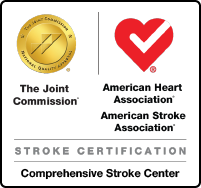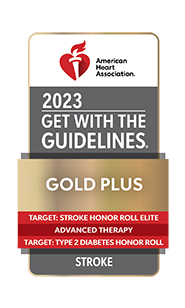Stroke, Blood Clot Patient Ann Kelly Receives Quick Life-Saving Care
It started off as a normal enough Monday for Ann Kelly.
Working the front desk at a Catonsville tech firm, 77-year-old Ann sped through her morning and was sitting down for lunch with her team, a bunch of youngsters who look to her as the office’s motherly figure.
When her coworkers noticed her arm shaking, face drooping and speech slurred, they quickly realized that something was terribly wrong.
“We’re all laughing and joking like we always do, and Ms. Ann starts making a strange noise,” said Lynette Smith, who works with Ann. “I thought she was playing around and joking, then I looked at her face and I saw one side go limp. I said ‘something’s wrong with Ms. Ann. Call 911.”
Thanks to that quick action, Ann is still alive and well today after being treated for an acute stroke at the University of Maryland Medical Center.
Knowing the signs of a stroke and taking quick action are critical for stroke patients.
While eating lunch, Ann’s coworkers saw those signs and called 911 immediately. 10 minutes later, an ambulance arrived. Waiting for the ambulance’s arrival, Ann tried to get up from the barstool she was sitting on, but her coworkers steadied her and moved her to a more comfortable chair nearby. One coworkers kissed her on the cheek. Another was crying.
Ann remembers it all.
“It was frustrating because I couldn’t talk to them but I knew what was going on,” Ann said.
She was transported to St. Agnes Hospital where, by blinking her eyes, she consented to being transported to the University of Maryland Medical Center’s Comprehensive Stroke Center, one of the top-performing stroke treatment centers in Maryland. The stroke team at University of Maryland was activated while the patient was still at St. Agnes and they were fully prepared for emergent removal of blood clot that was obstructing the blood flow to Ann’s brain.
After arriving, she was found to have a major, life-threatening stroke. She could not speak or move the right side of her body. She was evaluated by vascular neurologist John Cole, MD, MS, and interventional neuroradiologist Dheeraj Gandhi, MBBS, and transferred immediately to the angiography suite. Ann received life-saving surgery (mechanical thrombectomy) from Dr. Gandhi. A large clot was removed from her brain artery, restoring blood flow immediately to her brain. The removal of the clot immediately restored functions that Ann lost because of the stroke. Two days after the surgery, she was back at home and even attended church that Sunday.
“I even remember the surgery,” Ann said. “I remember Dr. Gandhi removing the clot and him making sure that I stayed still. Then I could feel movement in my right leg. … It was a miracle.”
A Laurel, Md., resident, Ann didn’t wait long before returning to work. Just 10 days after the stroke, she was back at the front desk at work, even driving herself in.
“Everyone said, ‘We know you wanted the day off, but don’t scare us like that!’” Ann said.
Ann said that everyone who took care of her – from the team at St. Agnes to everyone at UMMC – couldn’t have been more kind. She constantly received reassurances that everything would be okay.
Her advice to stroke patients: don’t be afraid. Even though you can’t communicate or operate normally, know that if you receive timely care, you’ll get the care you need.
“I just think that the staff and the doctors for stroke victims are not given enough credit,” Ann said. “Every staff member I came in contact with there left my heart warm. Those are some of the most caring people. I couldn’t have been in a better place.”



